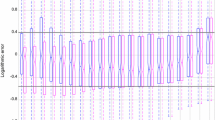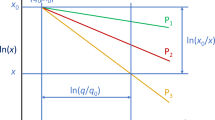Abstract
A wave superposition code was developed to calculate stresses explosivley induced by long, multiple blast holes within a three dimensional rock mass. Computed stresses were found to correlate with measured fragmentation from fourteen cases in coal cyclotherm geology when actual, rather than planned, initiation times were modelled.
Similar content being viewed by others
References
Aimone, C. T. (1982): Three-Dimensional Wave Propagation Model of Full-Scale-Rock Fragmentation. Ph. D. Dissertation, Northwestern University, 285.
Aimone, C. T., Dowding, C. H., (1983): Fragmentation Measurement Results for Fourteen Full-Scale Production Blasts. Proceedings of the Ninth Conference on Explosives and Blasting Technique. Soc. of Explosive Engineers, Montville, Ohio, 310–333.
Ash, R. L. (1973): The Influence of Geological Discontinuities on Rock Blasting. Ph. D. Dissertation, University of Minnesota, 288.
Atchison, T. C., Tournay, W. C. (1959): Comparative Studies of Explosives in Granite. United States Bureau of Mines, Report of Investigation 5509.
Bergmann, O. R., Wu, F. C., Edl, J. W. (1974): Model Rock Blasting Measures Effects of Delays and Hole Pattens on Rock Fragmentation. Engng. Min. J. June, 124–127.
Carter, J. W. (1977): Analysis of a Simple Photographic Method Proposed for Determining Size Distribution of the Fragments. Laboratory Report RBM 77-03, Rock Mass Behavior Group, United States Bureau of Mines Research Center, Denver, Colorado.
Cook, M. A. (1958): The Science of High Explosives. New York: Robert E. Krieger Publishing Company.
Diennes, J. K. (1981): On the Effects of Anisotrophy in Explosive Fragmentation. Proceeding of the Twenty-first Symposium on Rock Mechanics, Cambridge, Massachusetts, 164–170.
Duvall, W. I. (1953): Strain-Wave Shapes in Rock Near Explosions. Geophysics18 (no. 2), 310–326.
Duvall, W. I., Atchison, T. C. (1957): Rock Breakage by Explosives. United States Bureau of Mines Report of Investigation 5356.
Favreau, R. F. (1969): Generation of Strain Waves in Rock by an Explosion in a Spherical Cavity. J. of Geophys. Res.74, (no. 17), 4267–4280.
Favreau, R. F. (1980): “BLASPA”, A Practical Blasting Optimization System. Proceedings of the Sixth Conference on Explosives and Blasting Techniques, Tampa, Florida, 164–174.
Grady, D. E., Kipp, M. E. (1980): Continuum Modeling of Explosive Fracture in Oil Shale. Int. J. Rock Mech. Min. Sc.17, 147–159.
Holmberg, R., Rostan, A. (1983): First International Symposium on Rock Fragmentation by Blasting. Lulea University of Technology, Sweden.
Johnson, J. N. (1979): Calculation of Explosive Rock Breakage. Proceedings of the Twentieth Symposium on Rock Mechanics, Austin, 109, 118.
Kutter, H. K., Fairhurst, C. (1971): On the Fracture Process in Blasting. Int. J. Rock Mech. Min. Sc.8, 181–202.
Langefors, U., Kilhstrom, B. (1963). The Modern Technique of Rock Blasting. New York: John Wiley Sons, Inc.
Margolin, L. B. (1981): Private Communication. Los Alamos, U. S. A.
McHugh, S. L., Curran, D. R., Jeaman, L. (1980): The NAG-FRAG Computational Fracture Model and Its Use for Simulating Fragmentation and Fracture. Society for Experimental Stress Analysis, Proceedings, Fort Lauderdale, Florida, U. S. A., October.
Sharp, J. A. (1942): The Production of Elastic Waves by Explosive Pressures. I. Theory and Empirical Field Observations. Geophysics7 (no. 3), 144–154.
Smith, N. S. (1976): Fragmentation in Bench Blasting. Ph. D. Dissertation, University of Missouri, Columbia, Mo., U. S. A.
Starfield, A. M., Pugliese, J. M. (1968): Compressional Waves Generated in Rock by Cylindrical Explosive Charges, A Comparison Between a Computer Model and Field Measurements. Int. J. Rock Mech. Min. Sc.5, 67–77.
Trent, B. C., Yound, C., Barbour, T. G., Smith, J. W. (1981): A Coupled Gas Pressurization Fracture Model for Oil Shale Fragmentation. Proceedings of the Twenty-first Symposium on Rock Mechanics, Cambridge, Massachusetts, U.S.A.
Winzer, S. R. (1978): The Firing Times of MS Delay Blasting Caps and Their Effect on Blasting Performance. Report to The National Science Foundation, Contract DAR-77-05171.
Author information
Authors and Affiliations
Rights and permissions
About this article
Cite this article
Dowding, C.H., Aimone, C.T. Multiple blast-hole stresses and measured fragmentation. Rock Mech Rock Engng 18, 17–36 (1985). https://doi.org/10.1007/BF01020413
Issue Date:
DOI: https://doi.org/10.1007/BF01020413




